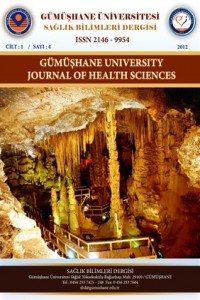Öz
This study was done to determine the prevalence of premenstrual syndrome and affecting factors among university students. The universe of this descriptive study conducted on 1052 female students who are living in the institution of Credit and Dorms in Gaziantep. This study was carried out between 12 November 2011 to 28 January 2012. This study was conducted with 282 students who agreed to participate in the research. A questionnaire consisting of 28 questions and the Premenstrual Syndrome Scale (PAF) were used for data collection. Chi-square test, mean standart deviation, number and percentages were used to evaluate the data. Mean age of the students was 20.52 ± 1.65 and mean age at menarche was determined to be 13.21 ± 1.30. The prevalence of Premenstrual Syndrome among female students was 51%. Students' average scores on PMS scale was found to be 116.56 ± 31.10. It was determined that in the premenstrual period, 70.2% students had changes in appetite, 68.1% had depressive mood, 65.6% of cases had fatigue, 64.2% irritability, 62.4% swelling, 61.7% pain, 50.7% had sleep changes, 42.6% of cases had depressive thoughts and 20.6% had anxiety symptoms. When examine the factors affecting PMS, we found that PMS was more common among students who think that they had insufficient information about menstruation (x2 = 3.820), who have had negative attitudes towards menstruation (x2 = 3.302), have dysmenorrhea (x2 = 4.162), have PMS (x2 = 11.032) and whose mothers have had PMS (x2 = 4.162). A statistically significant difference was found between the variables (p <0.05). In order to decrease the negative effects of PMS, it is recommended to create awareness about PMS and school health nurses or health professionals in the health care institutions to act as a consultant and educator in the support of students about PMS.
Anahtar Kelimeler
Premenstrual syndrome Menstrual problems Youth Reproductive Health
Öz
Bu çalışma üniversite öğrencisi olan genç kızlarda premenstrual sendrom sıklığını belirlemek ve etkileyen faktörleri incelemek amacıyla yapılmıştır. Tanımlayıcı olan çalışmanın evrenini Gaziantep ili Kredi ve Yurtlar Kurumu'nda kalan 1052 kız öğrenci oluşturmuştur. Araştırmaya katılmayı kabul eden 282 öğrenci ile çalışma gerçekleştirilmiştir. Çalışma 12 Kasım- 28 Ocak 2011 tarihleri arasında uygulanmıştır. Veriler 28 sorudan oluşan anket formu ve Premenstrual Sendrom Ölçeği (PMSÖ) kullanılarak toplanmıştır. Verilerin değerlendirilmesinde ki-kare testi, ortalama, standart sapma, sayı ve yüzde kullanılmıştır. Öğrencilerin yaş ortalamalarının 20.52±1.65 ve menarş yaşı ortalamalarının 13.21 ± 1.30 olduğu belirlenmiştir. Öğrencilerin PMSÖ'den aldıkları puana göre PMS prevalansı %57.4 olarak belirlenmiştir. Öğrencilerin PMSÖ'inden aldıkları puan ortalaması 116.56 ± 31.10 olarak saptanmıştır. Premenstrual dönemde öğrencilerin %70.2'sinde iştah değişimleri, %68.1'inde depresif duygulanım, %65.6'sında yorgunluk, %64.2'sinde sinirlilik, %62.4'ünde şişkinlik, %61.7'sinde ağrı, %50.7'sinde uyku değişimleri, %42.6'sında depresif düşünceler ve %20.6'sında anksiyete yakınmalarının görüldüğü belirlenmiştir. PMS etkileyen faktörler incelendiğinde; menstruasyona ilişkin aldığı bilginin yetersiz olduğu düşünen (x2 = 3.820), menstruasyon görmeye ilişkin olumsuz tepkileri olan (x2 = 3.302), dismenore yaşayan (x2 = 4.162), kendisinin (x2 = 11.032) ve annesinin (x2 = 4.162) premenstrual yakınmalar yaşadığını belirten öğrencilerin PMS yaşadığı belirlenmiştir. Yapılan istatistiksel değerlendirmede değişkenler arasındaki fark istatistiksel olarak anlamlı bulunmuştur (p < 0.05). PMS'nin olumsuz etkilerinin daha az yaşanması için okul sağlığı hemşirelerinin ve sağlık profesyonellerinin eğitimci ve danışman olarak öğrencilere destek olmaları önerilmektedir.
Anahtar Kelimeler
Premenstrual Sendrom Menstrual Sorunlar Gençlik Üreme Sağlığı
Ayrıntılar
| Birincil Dil | Türkçe |
|---|---|
| Yazarlar | |
| Yayımlanma Tarihi | 1 Ekim 2012 |
| Yayımlandığı Sayı | Yıl 2012 Cilt: 1 Sayı: 4 |

